At a glance
The best way to help protect young infants from whooping cough is for their mothers to get a tetanus toxoid, reduced diphtheria toxoid, and acellular pertussis (Tdap) vaccination during pregnancy. To estimate Tdap vaccination coverage among pregnant women, CDC analyzed data on Tdap vaccination from two Internet panel surveys.
Authors: Katherine E. Kahn, MPH; Carla L. Black, PhD; Helen Ding, MD, MSPH; Amy Parker Fiebelkorn, MSN, MPH; Jennifer L. Liang; DVM; Indu B. Ahluwalia, PhD; Sarah W. Ball, ScD; Sara M.A. Donahue, DrPH, MPH; Rebecca Fink, MPH; Rebecca Devlin, MA
Leidos, Atlanta, GA; Immunization Services Division, National Center for Immunization and Respiratory Disease, CDC; Eagle Medical Services, LLC, San Antonio, TX; Division of Bacterial Diseases, National Center for Immunization and Respiratory Disease, CDC; Division of Reproductive Health, National Center for Chronic Disease Prevention and Health Promotion, CDC; Abt Associates Inc., Cambridge, MA; Abt SRBI, New York, NY.
Summary
Pertussis (whooping cough) is a contagious respiratory illness that can lead to hospitalization and death, especially among infants <12 months12.
Infants are not recommended to be vaccinated against whooping cough until they are 2 months old12. The best way to help protect young infants from whooping cough is for their mothers to get a tetanus toxoid, reduced diphtheria toxoid, and acellular pertussis (Tdap) vaccination during pregnancy3. Infants whose mothers get a Tdap vaccination while pregnant have a lower risk of getting whooping cough and related complications early in life3456. Two studies from the United Kingdom suggest that up to 90% of infants are protected against whooping cough by vaccination of their mother during pregnancy78. Since late 2012, CDC, the American College of Obstetricians and Gynecologists, the American College of Nurse-Midwives, and the American Academy of Family Physicians recommend that women receive a Tdap vaccination during every pregnancy, optimally at 27 through 36 weeks of gestation3456.
Few recent national estimates of Tdap vaccination coverage among pregnant women are available. Based on the Pregnancy Risk Assessment Monitoring System (PRAMS) in 2011, before Tdap vaccination was recommended during every pregnancy, 9.7% of women who had a live birth were vaccinated during their pregnancy9.
To estimate Tdap vaccination coverage among pregnant women, CDC analyzed data on Tdap vaccination from two Internet panel surveys. The first survey was conducted March 31 through April 11, 2014, among women who were pregnant any time since August 2013, and the second survey was conducted March 31 through April 6, 2015, among women who were pregnant any time since August 2014. Women who had completed their pregnancy and delivered a live infant at the time of the surveys were included in the analysis. Differences of at least five percentage points between estimates are noted.
Figure 1. Receipt of most recent Tdap vaccination among recently pregnant women who had a live birth, Internet panel surveys, United States, April 2014 and April 2015
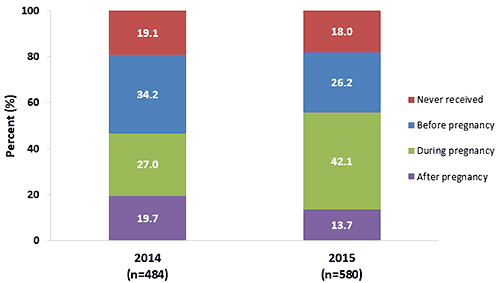
Key Findings
- In 2015, Tdap vaccination coverage during pregnancy among women who had a live birth was 42.1%, an increase compared with 2014 vaccination coverage (27.0%).
- The proportion of recently pregnant women who received their most recent Tdap vaccination before or after pregnancy decreased in 2015 (39.9%) compared with 2014 (53.9%), as vaccination coverage during pregnancy increased in agreement with the recommendation.
- The proportion of recently pregnant women who reported never receiving a Tdap vaccination was similar in 2015 (18.0%) compared with 2014 (19.1%).
- The proportion of recently pregnant women who received their most recent Tdap vaccination before or after pregnancy decreased in 2015 (39.9%) compared with 2014 (53.9%), as vaccination coverage during pregnancy increased in agreement with the recommendation.
- Among respondents to the 2015 Internet panel survey who had visited a doctor or other medical professional since July 1, 2014, 63.2% received an offer of Tdap vaccination, 15.0% received a recommendation for but no offer of vaccination, and 21.7% did not receive a recommendation for Tdap vaccination.
- Women who received a recommendation for and an offer of Tdap vaccination from a doctor or other medical professional were more likely to be vaccinated during pregnancy.
- These women were over three times more likely to be vaccinated during pregnancy compared with women who received only a recommendation for vaccination but no offer of vaccination (61.0% versus 19.7%).
- They were more than twenty-six times more likely to be vaccinated compared with women who did not receive a recommendation for vaccination (61.0% versus 2.3%).
- These women were over three times more likely to be vaccinated during pregnancy compared with women who received only a recommendation for vaccination but no offer of vaccination (61.0% versus 19.7%).
Conclusion/Recommendation
Health care personnel are encouraged to strongly recommend and offer Tdap vaccination to pregnant women during every pregnancy, optimally at 27 through 36 weeks gestation, to help prevent whooping cough in their infants.
Who Was Vaccinated?
In 2014, younger (18-24 years) and older (35-49 years) pregnant women were less likely to be vaccinated (23.8% and 21.0%, respectively) than pregnant women 25-34 years (30.5%). In 2015, coverage among all age groups was similar. Coverage was higher in 2015 compared with 2014 among pregnant women in all age groups.
Figure 2. Tdap vaccination coverage during pregnancy among recently pregnant women who had a live birth, by age, Internet panel surveys, United States, April 2014 (n=484) and April 2015 (n=580)A
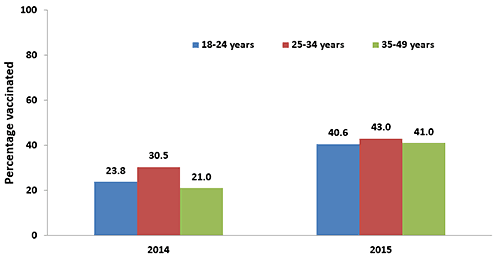
- In 2014, Tdap vaccination coverage was highest among non-Hispanic white women (33.5%) compared with non-Hispanic black (10.3%), Hispanic (24.3%), and non-Hispanic other women (25.6%).
- In 2015, coverage among non-Hispanic other women (47.4%) was higher compared with non-Hispanic white women (42.2%) and non-Hispanic black women (38.3%).
- Coverage was higher in 2015 compared with 2014 among women in all race/ethnicity groups.
Figure 3. Tdap vaccination coverage during pregnancy among recently pregnant women who had a live , by race/, Internet panel surveys, United States, April 2014 (n=484) and April 2015 (n=580)

- In 2014, Tdap vaccination coverage was higher among pregnant women with more than a college degree (33.5%) compared with women with a high school diploma or less (26.7%) and women with some college education (22.0%).
- Women with a college degree had higher coverage (28.9%) than women with some college education (22.0%).
- In 2015, coverage was higher among women with a high school diploma or less (47.4%) compared with women who had some college education (41.2%) and women with a college degree (38.6%).
- Women with more than a college degree (44.6%) had higher coverage than women with a college degree (38.6%).
- Coverage was higher in 2015 compared with 2014 among women at all education levels.
Figure 4. Tdap vaccination coverage during pregnancy among recently pregnant women who had a live birth, by education, Internet panel surveys, United States, April 2014 (n=484) and April 2015 (n=580)A
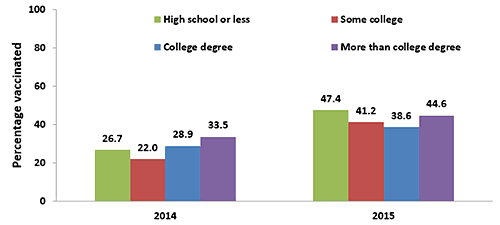
- In both 2014 and 2015, pregnant women who reported having private/military medical insurance as their only insurance during pregnancy had higher vaccination coverage (30.0% and 45.5%, respectively) than women who reported having any type of public medical insurance (24.8% and 37.9%, respectively).
- Tdap vaccination coverage was higher in 2015 compared with 2014 among all women regardless of insurance type.
Figure 5. Tdap vaccination coverage during pregnancy among recently pregnant women who had a live , by type of medical , Internet panel surveys, United States, April 2014 (n=474) and April 2015 (n=567)
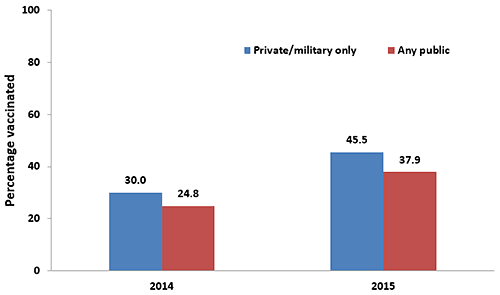
- In both 2014 and 2015, pregnant women who were living below poverty had similar vaccination coverage compared with women who were living at or above poverty.
- Tdap vaccination coverage increased in 2015 compared with 2014 among all women regardless of poverty status.
Figure 6. Tdap vaccination coverage during pregnancy among recently pregnant women who had a live birth, by poverty status, Internet panel surveys, United States, April 2014 (n=482) and April 2015 (n=578)CA

- In 2015, among women who reported visiting a doctor or other medical professional at least once since July 1, 2014, 63.2% reported receiving an offer of Tdap vaccination from a doctor or other medical professional, 15.0% received a recommendation but were not offered the vaccine, and 21.7% did not receive a recommendation for Tdap vaccination.
- Tdap vaccination coverage among pregnant women was highest (61.0%) among women who reported that their doctor or other medical professional offered the vaccination.
- Among pregnant women who reported receiving a recommendation for but no offer of vaccination from their doctor or other medical professional, 19.7% were vaccinated.
- Only 2.3% of pregnant women who reported that they did not receive a recommendation for vaccination from their doctor or other medical professional were vaccinated.
- Among pregnant women who reported receiving a recommendation for but no offer of vaccination from their doctor or other medical professional, 19.7% were vaccinated.
Figure 7. Tdap vaccination coverage during pregnancy among recently pregnant women who had a live , by medical professional recommendation and offer of Tdap , Internet panel survey, United States, April 2015 (n=578)
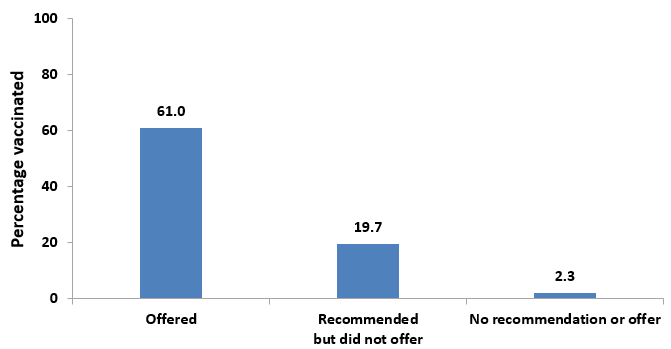
In 2015, respondents who had never received a Tdap vaccination or who had been vaccinated but not during their most recent pregnancy were asked to report their reasons for not receiving Tdap vaccination.
- The most commonly reported reasons for not receiving Tdap vaccination indicated a lack of awareness regarding Tdap vaccination and the recommendation to receive Tdap vaccination during pregnancy (43.7%).
- Other commonly reported reasons were related to safety risks or side effects of vaccination, and included concern about side effects, vaccination-related safety risks to the mother, and vaccination-related safety risks to her baby (23.9%).
- Potential barriers to vaccination access, such as lack of medical insurance or cost (3.0%) and lack of time (3.4%) were reported much less frequently as reasons for not receiving Tdap vaccination.
Figure 8. Most commonly reported for not receiving Tdap vaccination among recently pregnant women who had a live birth and did not receive Tdap during their most recent pregnancy, Internet panel survey, United States, April 2015 (n=355)
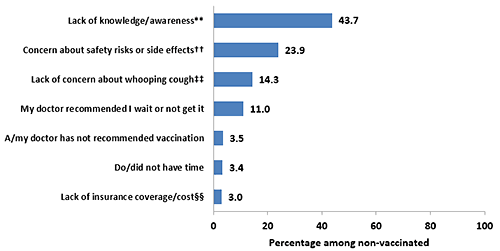
What Can Be Done?
Overall, estimates of Tdap vaccination coverage during pregnancy from the 2015 survey were higher compared with estimates from the 2014 survey. In 2015, Tdap vaccination coverage was highest among pregnant women who reported that their doctor or other medical professional offered Tdap vaccination (61.0%) compared to pregnant women who reported receiving a recommendation without an offer of vaccine (19.7%) and did not receive a recommendation at all (2.3%). The most common reasons for not receiving a Tdap vaccination were related to a lack of awareness about the need for Tdap vaccination (43.7%) and concern about safety risks or side effects related to Tdap vaccination (23.9%). Continued efforts are needed to improve Tdap vaccination coverage among pregnant women, including:
- All HCP should assess the vaccination status of pregnant women at every health care visit.
- A recommendation with an offer of vaccination from a doctor or other medical professional has been strongly associated with vaccination during pregnancy.
- If all pregnant women are assessed for vaccination status at every health care visit and receive both a recommendation for and offer of Tdap vaccination from their HCP, vaccination coverage should increase.
- More than half of the recently pregnant women who had a live birth in the 2015 survey had not been vaccinated during their most recent pregnancy.
- HCP should encourage their pregnant patients to receive Tdap vaccination at 27 through 36 weeks of pregnancy to give their infants the most protection at birth, since protective antibodies will be at their highest about two weeks after getting the vaccine [3].
- HCP who are not able to stock and offer the Tdap vaccine themselves should offer their pregnant patients a strong referral, providing specific information on where patients can go to get the vaccine, and a patient-specific prescription if needed. HCP should also follow up with patients to ensure that the vaccination was obtained.
- The most commonly reported reasons women reported not being vaccinated during their most recent pregnancy indicated lack of awareness of the vaccine recommendation.
- HCP and immunization programs should provide pregnant women with accurate information on the following topics:
- The risk of whooping cough and related complications in infants, including hospitalization and death;
- The benefits and safety of Tdap vaccination for mothers and their infants; and
- The protection transferred to developing infants by Tdap vaccination during pregnancy, since infants younger than two months old cannot be vaccinated themselves.
- The risk of whooping cough and related complications in infants, including hospitalization and death;
- Information is available at:
- American College of Obstetricians and Gynecologists. Frequently Asked Questions for Pregnant Women Concerning Tdap Vaccination. 2015.
- American College of Obstetricians and Gynecologists. Physician Script Concerning Tdap Vaccination. 2013.
- American College of Nurse-Midwifes. Immunization Resources for Providers.
- CDC. Pregnancy and Whooping Cough.
- CDC. You Can Start Protecting Your Baby from Whooping Cough Before Birth.
- CDC. Letter to Providers: Tdap and Influenza Vaccination of Pregnant Women.
- Text4baby. Texts to keep you and baby healthy.
- American College of Obstetricians and Gynecologists. Frequently Asked Questions for Pregnant Women Concerning Tdap Vaccination. 2015.
Data Source and Methods
CDC conducted Internet panel surveys from March 31–April 11, 2014 and March 31–April 6, 2015 to assess end-of-season influenza (flu) vaccination coverage estimates among pregnant women1011. Questions about Tdap vaccination were included in both surveys. Questions about recommendation for and offer of Tdap vaccination from a medical professional and reasons for not receiving Tdap vaccination were added in 2015. Women 18–49 years who were pregnant at any time since August 1, 2013 for the 2014 survey, or since August 1, 2014 for the 2015 survey, were eligible for the survey. Participants were recruited from pre-existing, national, opt-in, general population Internet panels operated by Survey Sampling International, which provides panel members with online survey opportunities in exchange for nominal incentives. In 2014, of 2,127 panel members who were eligible and started the survey, 2,042 (96.0%) completed the online survey; and in 2015, 2,053 (94.6%) of 2,171 eligible panel members completed the survey. Data were weighted to reflect the age, race/ethnicity, and geographic distribution of the total U.S. population of pregnant women12131415.
Survey respondents were asked if they ever had a Tdap vaccination and, if so, whether they received their most recent vaccination before, during, or after their most recent pregnancy. Pregnancy status questions included whether respondents were currently pregnant at the time of the survey or had been pregnant any time since August 1, 2013 in the 2014 survey, and since August 1, 2014 in the 2015 survey. Recently pregnant women were asked if they had a live birth. The current analysis included only recently pregnant women who had a live birth. Women who reported receiving vaccination during their most recent pregnancy were counted as vaccinated during pregnancy, while women who reported never being vaccinated or being vaccinated before or after their most recent pregnancy were counted as not vaccinated during pregnancy. In the 2014 survey, 91 out of 575 women with a live birth (15.8%) were not included in the analysis because they did not know if they had ever received a Tdap vaccination or did not know if the Tdap vaccination was received during their pregnancy, leaving a final analytic sample of 484. In the 2015 survey, 106 out of 686 women with a live birth were not included (15.5%), leaving a final analytic sample of 580. In 2015, respondents who had at least one medical visit since the preceding July were asked if any doctor or other medical professional had recommended or offered Tdap vaccination during their most recent pregnancy. Also in 2015, respondents who had not received Tdap vaccination during their most recent pregnancy were asked about reasons why they were not vaccinated.
Weighted analyses were conducted using SAS v9.2 survey procedures. Because the opt-in Internet panel samples were based on those who initially self-selected for participation in each panel rather than random probability samples, statistical measures, such as calculation of confidence intervals and tests of differences, were not performed16 A change between years, or a difference between groups, was noted when there was a difference in estimates of at least five percentage points.
Sample Demographics
A total of 484 and 580 women who were pregnant any time from August 1, 2013 or August 1, 2014, until completion of the survey in 2014 or 2015, respectively, were included in the analysis. Table 1 shows the frequency of women in each demographic subgroup in the 2014 and 2015 surveys.
Table 1. Demographic characteristics of recently pregnant women who had a live birth, United States, Internet panel surveys, April 2014 and April 2015A
| Characteristics | 2014 unweighted n |
2014 weighted % |
2015 unweighted n |
2015 weighted % |
|---|---|---|---|---|
| Overall | 484 | 100.0 | 580 | 100.0 |
| Age group | ||||
| 18-24 years | 99 | 30.0 | 130 | 25.9 |
| 25-34 years | 299 | 54.4 | 350 | 59.1 |
| 35-49 years | 86 | 15.6 | 100 | 15.1 |
| Race/ethnicity† | ||||
| Non-Hispanic white | 334 | 56.4 | 345 | 57.5 |
| Non-Hispanic black | 47 | 18.5 | 77 | 17.3 |
| Hispanic | 62 | 18.4 | 112 | 17.4 |
| Non-Hispanic other | 41 | 6.6 | 46 | 7.8 |
| Education | ||||
| High school degree or less | 89 | 21.3 | 130 | 23.3 |
| Some college | 127 | 28.9 | 168 | 29.2 |
| College degree | 196 | 37.6 | 215 | 36.3 |
| More than a college degree | 72 | 12.2 | 67 | 11.2 |
| Insurance status‡ | ||||
| Private/military insurance only | 301 | 57.4 | 320 | 55.0 |
| Any public insurance | 172 | 42.6 | 247 | 45.0 |
| Living in poverty§ | ||||
| At or above poverty | 386 | 74.8 | 446 | 75.5 |
| Below poverty | 96 | 25.2 | 132 | 24.5 |
Limitations
The findings in the report are subject to several limitations.
- The sample was not necessarily representative of all pregnant women in the United States because the survey was conducted among a smaller group of volunteers who were already enrolled in a preexisting, national, opt-in, general-population Internet panel rather than a randomly selected sample.
- Some bias might remain after weighting adjustments, given the exclusion of women with no Internet access and the self-selection processes for entry into the panel and participation in the survey. Estimates might be biased if the selection processes for entry into the Internet panel and a woman's decision to participate in this particular survey were related to receipt of vaccination.
- All results are based on self-report and not validated by medical record review. However, our vaccination coverage estimates are similar to a recently published estimate based on provider-reported data from the Vaccine Safety Datalink (VSD) sites (42.1%)17
- Baker R, Brick JM, Bates NA, et al. Summary report of the AAPOR Task Force on non-probability sampling. J Surv Stat Methodol 2013;1:90–143.
- Formal statistics were not used to determine differences in vaccination coverage estimates between groups and seasons.
- Some subgroups had small sample sizes.
- Estimates could be biased due to the exclusion of ~13% of respondents who did not know their vaccination status. Sensitivity analysis showed that actual vaccination could have ranged from 43.0% to 55.0% in 2016.
Despite these limitations, Internet panel surveys are considered a useful assessment tool for timely evaluation of Tdap vaccination coverage during pregnancy.
Related Links
- Frequently Asked Questions for Patients Concerning Tdap Vaccination
- Pregnant? Get Tdap in Your Third Trimester
- Standards for Adult Immunization Practice
- Updated Recommendations for Use of Tetanus Toxoid, Reduced Diphtheria Toxoid, and Acellular Pertussis Vaccine (Tdap) in Pregnant Women — Advisory Committee on Immunization Practices (ACIP), 2012
- Text4Baby
- * Respondents were asked if they were currently pregnant or had been pregnant any time since August 1, 2013 or 2014 in the 2014 and 2015 surveys, respectively. Women were included in the analysis if they were recently pregnant (since August 1st), had delivered a live birth, and knew their Tdap vaccination status and timing of their most recent vaccination.
- † Race/ethnicity was self-reported. Women categorized as white, black, or other race were identified as non-Hispanic. The other race category included Asians, American Indians and Alaska Natives, Native Hawaiian or other Pacific Islander, multiracial, and other races. Women identified as Hispanic might be of any race.
- § Poverty status was defined based on the reported number of people and children living in the household and annual household income, and the U.S. Census poverty thresholds
- || Respondents who reported seeing a doctor or other medical professional since July 2014 in the 2015 survey were asked if a doctor or other medical professional had recommended or offered Tdap vaccination during their pregnancy. Nearly all (99.8%) participants included in the study had seen a doctor or medical professional since July 2014. Questions regarding provider recommendation and offer of Tdap vaccination were not included in the 2014 survey.
- Kretsinger K, Broder KR, Cortese MM, Joyce MP, Ortega-Sanchez I, Lee GM, Tiwari T, Cohn AC, Slade BA, Iskander JK, Mijalski CM, Brown KH, Murphy TV. Preventing Tetanus, Diphtheria, and Pertussis Among Adults: Use of Tetanus Toxoid, Reduced Diphtheria Toxoid and Acellular Pertussis Vaccine. MMWR 2006;55(RR17):1-33. Accessed on 1/11/2016.
- CDC. Updated Recommendations for Use of Tetanus Toxoid, Reduced Diphtheria Toxoid and Acellular Pertussis Vaccine (Tdap) in Pregnant Women and Persons Who Have or Anticipate Having Close Contact with an Infant Aged <12 Months — Advisory Committee on Immunization Practices (ACIP), 2011. MMWR 2011;60(41):1424-26. Accessed on 1/11/2016.
- Sawyer M, Liang JL, Messonnier N, Clark TA. Updated Recommendations for Use of Tetanus Toxoid, Reduced Diphtheria Toxoid, and Acellular Pertussis Vaccine (Tdap) in Pregnant Women – Advisory Committee on Immunization Practices (ACIP), 2012. MMWR 2013;62(7):131-5. Accessed 1/4/2016.
- ACOG. Update on Immunization and Pregnancy: Tetanus Diphtheria and Pertussis Vaccination. Committee Opinion No. 566. Obstet Gynecol 2013;121:1411–4. Accessed 1/11/2016.
- ACOG. Immunization for women. 2015. Accessed 1/4/2016.
- CDC. You Can Start Protecting Your Baby from Whooping Cough before Birth. 2015. Accessed 1/4/2016.
- Amirthalingam G, Andrews N, Campbell H, Ribeiro S, Kara E, Donegan K, Fry NK, Miller E, Ramsay M. Effectiveness of maternal pertussis vaccination in England: An observational study. Lancet 2014;384(9953):1521–28.
- Dabrera G, Amirthalingam G, Andrews N, Campbell H, Ribeiro S, Kara E, Fry NK, Ramsay M. A case-control study to estimate the effectiveness of maternal pertussis vaccination in protecting newborn infants in England and Wales, 2012-2013. Clin Infect Dis 2015;60(3):333-7.
- Ahluwalia IB, Ding H, D’Angelo D, Shealy KH, Singleton JA, Liang J, Rosenberg, KD. Tetanus, Diphtheria, Pertussis Vaccination Coverage Before, During, and After Pregnancy — 16 States and New York City, 2011. MMWR 2015;64(19):522-6. Accessed 4/14/2016.
- Ding H, Black CL, Ball S, Donahue S, Izrael D, Williams WW, Kennedy ED, Bridges CB, Lu PJ, Kahn KE, Grohskopf LA, Ahluwalia IB, Sokolowski J, DiSogra C, Walker DK, Greby SM. Influenza Vaccination Coverage Among Pregnant Women — United States, 2013–14 Influenza Season. MMWR 2014;63(37):816-21. Accessed 1/12/2016.
- Ding H, Black CL, Ball S, Donahue S, Fink RV, Williams WW, Kennedy ED, Bridges CB, Lu PJ, Kahn KE, Dean AK, Grohskopf LA, Ahluwalia IB, Devlin R, DiSogra C, Walker DK, Greby SM. Influenza Vaccination Coverage Among Pregnant Women — United States, 2014–15 Influenza Season. MMWR 2015;64(36):1000-5. Accessed 1/12/2016.
- Jones, RK, Jerman, J. Abortion Incidence and Service Availability in the United States, 2011. Perspect Sex Reprod Health 2014;46(1):3–14. Accessed 2/8/2016.
- Martin JA, Hamilton BE, Ventura SJ, Osterman MJK, Mathews TJ. Births: Final Data for 2011. National vital statistics reports; vol 62 no 1. Hyattsville, MD: National Center for Health Statistics. 2013. Accessed 2/8/2016.
- Ventura, SJ, Curtin SC, Abma JC, Henshaw SK. Estimated Pregnancy Rates and Rates of Pregnancy Outcomes for the United States, 1990–2008. National vital statistics reports; vol 60 no 7. Hyattsville, MD: National Center for Health Statistics. 2012. Accessed 2/8/2016.
- Curtin SC, Abma, JC, Ventura SJ, Henshaw SK. Pregnancy Rates for U.S. Women Continue to Drop. NCHS data brief, no 136. Hyattsville, MD: National Center for Health Statistics. 2013. Accessed 2/8/2016.
- Baker R, Brick JM, Bates NA, et al. Summary report of the AAPOR Task Force on non-probability sampling. J Surv Stat Methodol 2013;1:90–143.
- Kharbanda EO, Vazquez-Benitez G, Lipkind HS, et al. Maternal Tdap vaccination: Coverage and acute safety outcomes in the vaccine safety datalink, 2007–2013. Vaccine 2016;34(7):968-73.
- Baker R, Brick JM, Bates NA, Battaglia M, Couper MP, Dever JA, Gile KJ, Tourangeau R. Summary report of the AAPOR Task Force on non-probability sampling. J Surv Stat Methodol 2013;1:90–143.
- Kharbanda EO, Vazquez-Benitez G, Lipkind HS, Klein NP, Cheetham TC, Naleway AL, Lee GM, Hambidge S, Jackson ML, Omeri SB, McCarthyj N, Nordin JD. Maternal Tdap vaccination: Coverage and acute safety outcomes in the vaccine safety datalink, 2007–2013. Vaccine 2016;34(7):968-73.
- ‡ Women considered to have any public insurance selected at least one of the following when asked what kind of medical insurance they had: Medicaid, Medicare, Indian Health Service, state sponsored medical plan, or other government plan. Women considered to have private/military insurance selected only one or both of the following: private medical insurance or military medical insurance. Tdap vaccination coverage was not calculated for respondents who reported that they had no insurance of any type due to small numbers (n<30).
- ¶ Respondents who reported never receiving a Tdap vaccination were asked about their reasons for never receiving Tdap vaccination. Respondents who reported receiving Tdap vaccination but not during their most recent pregnancy were asked about their reasons for not receiving Tdap vaccination during pregnancy. Responses from the two groups of unvaccinated women were combined and similar responses grouped together. More than one reason could be selected. Questions regarding reasons for non-vaccination were not included in the 2014 survey.
- ** ‘Lack of knowledge/awareness’ included selection of one or more of the following responses: do/did not need the vaccination, didn’t know I was supposed to get the Tdap vaccine, didn’t know that I needed the Tdap vaccination during my pregnancy, never heard of the Tdap vaccine, or selected “other” and specified already received Tdap or was thought up to date on vaccination.
- †† ‘Concern about safety risks or side effects’ included selection of one or more of the following responses: concern about possible safety risks to my baby if I got vaccinated, concern about side effects, or concern about possible safety risks to myself if I got vaccinated.
- ‡‡ ‘Lack of concern about whooping cough’ included selection of one or more of the following responses: it’s unlikely my baby would get whooping cough, it’s unlikely I would get whooping cough, if I get whooping cough I will just get medication to treat it, or if my baby gets whooping cough I will just get medication to treat it.
- §§ ‘Lack of insurance coverage/cost’ included selection of one or more of the following responses: not covered by my insurance, don’t have insurance, co-pay costs too much, or Tdap vaccination costs too much.
